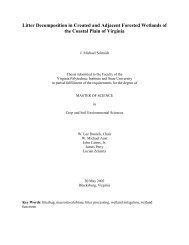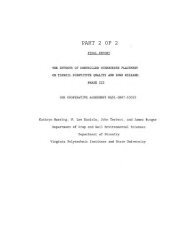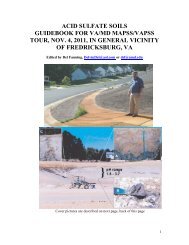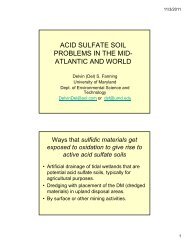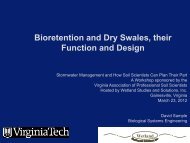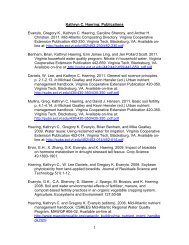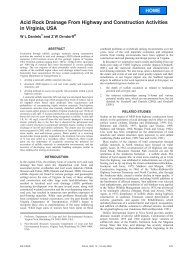Remediation of PAH-Contaminated Soils and Sediments: A ...
Remediation of PAH-Contaminated Soils and Sediments: A ...
Remediation of PAH-Contaminated Soils and Sediments: A ...
You also want an ePaper? Increase the reach of your titles
YUMPU automatically turns print PDFs into web optimized ePapers that Google loves.
dredged material into hazardous <strong>and</strong> non-hazardous waste. Furthermore, the<br />
transition <strong>of</strong> dredge material from slurried sediments to soils in upl<strong>and</strong> settings is<br />
not fully regulated under the CWA. The CWA only applies to dredge material<br />
management while in-water or dewatering, <strong>and</strong> not to the soils resulting from<br />
upl<strong>and</strong> placement (Childs et al., 2002). In general, water quality guidelines apply<br />
to the first phase <strong>of</strong> dredge sediment dewatering, <strong>and</strong> cleanup/solid waste<br />
program regulations apply during the second phase where the dredge material is<br />
considered a soil (Figure 12).<br />
Physical<br />
Characteristics<br />
Project Tasks<br />
Regulations<br />
Dredging<br />
Phase I Phase II<br />
SEDIMENT (WATER) SOIL (LAND)<br />
Federal: CWA<br />
Dredged<br />
Material<br />
Placed in<br />
Upl<strong>and</strong><br />
Containment<br />
State: Water quality st<strong>and</strong>ards<br />
Material<br />
Dewatering<br />
Dewatering<br />
Complete<br />
????????<br />
Beneficial<br />
Reuse<br />
Federal:<br />
RCRA<br />
State: soil<br />
cleanup <strong>and</strong><br />
solid waste<br />
Figure 12. Sediment <strong>and</strong> soil phases for dredged material. Grey area indicates<br />
the overlap between water <strong>and</strong> soil quality regulations <strong>and</strong> confusion. Adapted<br />
from Childs et al. (2002).<br />
Under the umbrella <strong>of</strong> federal regulations <strong>and</strong> EPA guidelines are state<br />
regulatory agencies such as the Virginia Department <strong>of</strong> Environmental Quality (or<br />
other state entity). Each state agency creates state-specific water <strong>and</strong> soil<br />
quality regulations <strong>and</strong> guidelines for h<strong>and</strong>ling, utilization <strong>and</strong> acceptable<br />
contaminant limits <strong>of</strong> dredge material. These guidelines can vary immensely<br />
among states in degree <strong>of</strong> specificity, stringency <strong>and</strong> perspectives on beneficial<br />
uses <strong>of</strong> dredge sediments. Most states, such as Illinois (IEPA, 2007) Minnesota<br />
(MPCA, 1999), <strong>and</strong> Oregon (Childs et al., 2002) regulate dredge sediments<br />
based on preexisting site remediation st<strong>and</strong>ards (water quality st<strong>and</strong>ards <strong>and</strong><br />
solid or hazardous waste guidelines or biosolid application guidelines). New<br />
Jersey (NJDEP, 1997), in attempt to deal with the overlap <strong>and</strong> confusion,<br />
developed regulations specific to dredge sediments, that are not regulated by<br />
either water or soil regulations already in place. This has eliminated the<br />
66



